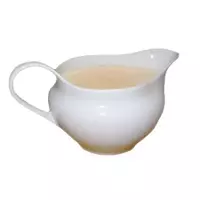Milk sauce

People began to eat milk as soon as they domesticated the first wild species of animals. If we approach the definition of milk from a biological point of view, then this product is nothing more than a nutrient fluid that is produced by the mammary glands of female mammals of animals. It is worth noting that nature took care of the survival of offspring, including human, endowing females with the ability to generate milk.
Perhaps the most common and widely used type of product can be considered cow's milk. As a result of large-scale studies, scientists were able to prove that cow's milk contains about 50 different types of compounds of natural origin. The chemical composition of milk is enriched with such certainly useful compounds for the human body as calcium, phosphorus, magnesium, potassium, as well as sulfur, iodine, zinc and selenium.
In addition, vitamins of group A, B, C, D, E, H, as well as PP can be found in the composition of milk. Milk is eaten fresh. In addition, in the food industry, milk undergoes some stages of heat treatment, resulting in new types of product. For example, pasteurized, melted or skimmed milk.
On the basis of milk, various fermented milk products are made (sour cream, cheese, cottage cheese, kefir, cream and others), which play an equally important role in the diet of the vast majority of the world's population. In addition, milk sauces are especially popular and in demand. The liquid seasoning of the main course or sauce received its original name thanks to the sophisticated French language.
Types of milk sauce
It is worth noting that it was the French chefs who came up with the lion's share of classic sauces, including a milk-based product. There is a fairly rich variety of types of milk sauces. which usually differ from each other in several parameters. Among the main types of milk sauces, the following can be distinguished:
sweet milk sauce;
salted milk sauce;
thick milk sauce;
semi-liquid milk sauce;
milk sauce of medium density or gravy.
In addition to the above classification, all milk sauces are divided into types depending on the composition of the original ingredients that were used in the cooking process. It is worth noting that various types of product have characteristic and distinctive taste, as well as consumer parameters. The calorie content of the milk sauce, as well as the type of product, depends on the recipe of the culinary product.
The average calorie level of milk sauce is at the level of 14
3. 4 Kcal, which are per 100 grams of product. Milk sauce is served to various culinary products. Often, with the help of milk sauces, it is possible to significantly improve the taste and other consumer characteristics of the finished dish. The thick milk sauce is used as a filling for homemade baking.
Medium-density milk sauce is more often used in the process of baking fish dishes. Liquid milk sauce is used as gravy for meat, fish and vegetable dishes. In addition, do not forget about the sweet milk sauce, which is used in pastry reproduction.
milk sauce 143.4 kCal
The energy value of milk sauce (Ratio of proteins, fats, carbohydrates - ju):
Proteins: 3 g (~ 12 kCal)
Fats: 11.5 g (~ 104 kCal)
Carbohydrates: 7.5 g (~ 30 kCal)
Energy ratio (bj | y): 8% | 72% | 21%
 Español
Español Français
Français Português
Português Русский
Русский 简体中文
简体中文 繁體中文
繁體中文 日本語
日本語 한국어
한국어 العربية
العربية Türkçe
Türkçe Қазақ
Қазақ Deutsch
Deutsch Italiano
Italiano Українська
Українська
